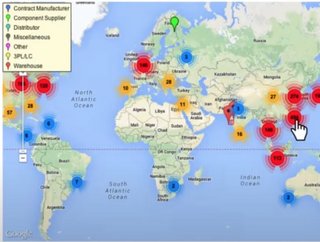Factory fire top supply chain disruption in 2022 - Resilinc

Supply chain mapping and risk monitoring company Resilinc has released a report revealing the top drivers of supply chain disruptions in 2022, with the data revealing that disruptions was up 32% year-on-year.
Usually when discussing supply chain disruption it is port congestion, extreme weather, war in Ukraine or Covid in China that are routinely cited, but the Resilinc report says that factory fires were the single biggest cause of supply disruption last year.
It reports that there were 3,609 factory fire alerts, a 85% year-on-year increase -- the most ever recorded in a single year. Resilinc blames the spike in fires on "gaps in regulatory and process execution" as well as on a shortage of skilled labour in warehouses.
Last year also saw a large increase in labour disruption around the globe, with a 92% year-on-year increase on this front. Examples of this are the protests at the Foxconn iPhone factory in China, and the Felixstowe port strike in the UK.
The Foxconn strike resulted in lower shipments of iPhone 14 Pro and iPhone 14 Pro Max models after Apple's Zhengzhou production plant was hit by a Covid-lockdown that sparked a mass walkout by its largely 20,000 migrant workforce.
Short on staff, Foxconn offered bonuses to workers to encourage them to return, but protests broke out when workers said management had reneged on their promises.
The strike in August 2022 at the UK Port of Felixstowe, meanwhile, resulted in US$800mn of disrupted trade, after an estimated 1,900 workers went on a nine-day strike in a dispute about a pay increase. Russell Group analysis shows that clothing ($82.8mn) and electronic components ($32.3mn) were most impacted by the industrial action.
Resilinc says leadership transitions -- including a new CEO at the shipping giant Maersk and the multinational healthcare company, Roche -- also saw a big jump this year, with a 77% increase over 2021. Top-level management changes can often lead to modifications in corporate strategy.
Geopolitical disruption saw a 378% increase from 2021, stemming from Russia's invasion of Ukraine, but did not make the top 10 list. Beyond that, airport disruptions jumped 189% and economic instability caused bankruptcies to climb over 270% last year.
Life sciences & healthcare supply chain badly hit
The five most disrupted industries were life sciences, healthcare, general manufacturing, hi-tech, and automotive, marking it the second year in a row these particular industries have been the most impacted.
Of all the 15,354 disruption notifications, more than half (56%) were impactful enough to trigger the creation of a WarRoom -- a virtual platform in the Resilinc dashboard where customers and their suppliers communicate and collaborate to assess and resolve disruptions.
Geographically, North America experienced the most disruptions accounting for just over half (51%) of the total alerts issued, followed by Europe and then Asia.
Resilinc’s data is gathered by its global event-monitoring AL engine, EventWatch, which collects information and monitors news on 400 types of disruption across 104 million sources, including traditional news, social media platforms, wire services, videos, and government reports.
Annually, EventWatch analyses 5 billion data feeds across 100 languages and countries, making it the industry’s most comprehensive supply chain risk monitoring portfolio.
The top 10 global supply chain disruptions for 2022
1. Factory fire
2. Mergers & acquisition
3. Business sale
4. Leadership transition
5. Factory disruption
6. Labour disruption
7. Legal action
8. Cyber attack
9. Recall
10. Port disruption






